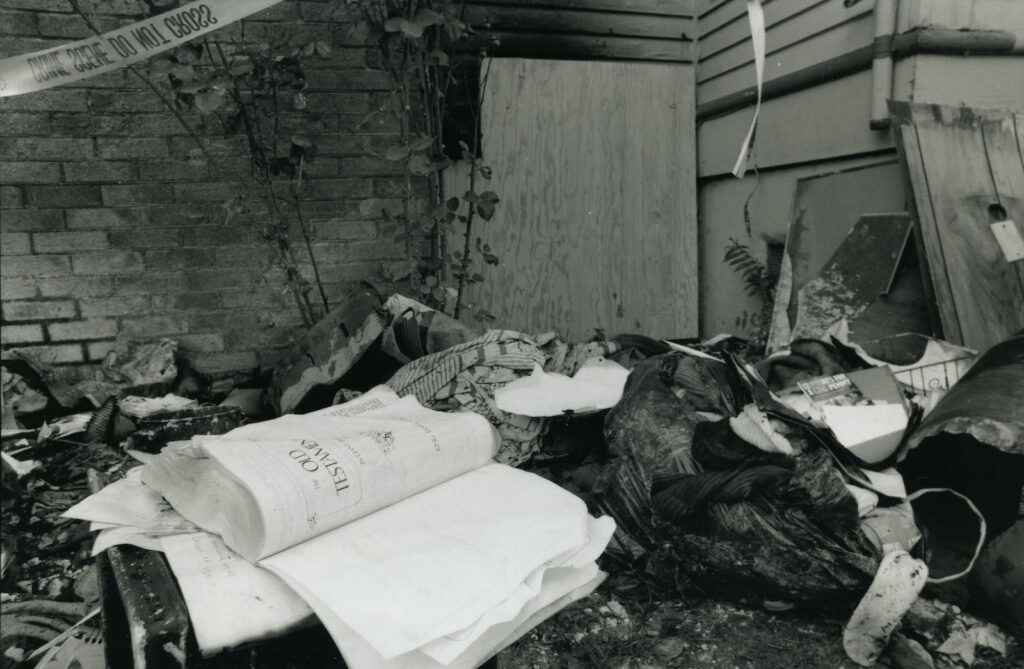The Interplay of Mainstream & Political Violence
We asked longtime civil rights organizer and No on 9 campaign leader Scot Nakagawa to reflect on the interplay of the different forms of violence that characterized the late ‘80s and early ‘90s in the Pacific Northwest. Let’s begin with the context – the violence that was already happening before the OCA ever filed their initiative petitions. Here’s what Scot remembers:
Gay bashings were mainstream in that time when anti-LGBTQ bigotry was so common as to be almost endemic. They might as easily be committed by law enforcement as by neo-Nazi street thugs.

The AIDS crisis, which peaked in the early ‘90s, incited a homophobic panic that evangelical right-wing groups exploited, suggesting that gay men were being punished by God for heathenistic and predatory sexual practices. This combined with the suggestion that gay men ‘recruited” vulnerable young boys created an explosive context in which extreme measures – from quarantines to executions of gay men who infected others – were proposed in evangelical right-wing circles and trickled out to impact mainstream media and policy making bodies up to and including the U.S. Congress.
Violence was also a fact of life for those subjected to racism, misogyny, and poverty – the kind of violence that is all around us, but isn’t integrated in the dominant narratives of society.
If you’re homeless in Oregon, you’re constantly vulnerable to violence and have little recourse when it’s visited on you. One of three women globally will experience violence in her lifetime. As a homeless gay teen, I was repeatedly assaulted, and, on one particularly notable occasion, by police officers who also occasionally picked me and friends of mine up, drove us out of the downtown core, and then dropped us off in the middle of nowhere for our own good.
The brutal street murder of Mulugeta Seraw in 1988 exposed another level of danger. White nationalist and, especially, neo-Nazi hate crimes represented the cutting edge of political violence in the 1990s. They made ordinary gay bashings seem relatively tame and even acceptable by comparison.
This was the environment in which the OCA introduced the potent poison of campaign propaganda that vilified LGBTQ people.
People nowadays forget what that propaganda looked like, but it was ugly and demonizing in the extreme. The ballot language named LGBTQ people as “abnormal, unnatural, wrong, and perverse,” and equated us with pedophiles, necrophiliacs, and people who commit acts of bestiality.
Of course that kind of propaganda is going to inspire violence. But when the propagandists base their claims in their Christian faith – basically calling us out as demons and agents of the devil – well, that’s like throwing gas on a fire already blazing out of control.
The OCA’s homophobic propaganda absolutely gave permission to ordinary folks to commit acts of intimidation and violence. The uptick in violence during the No on 9 campaign is clear on this.
Scot Nakagawa
The impact of the violence that accompanied the Ballot Measure 9 campaign took several forms. First, it was terrifying – not only for the LGBTQ community but for many allies who were visibly opposed to the measure, like the journalist who received death threats that earned him a police escort on more than one occasion. Second, it galvanized more people to speak out and vote against Measure 9.
It drove violence into the dominant narrative and polarized the community in a way that put many, many more people from all walks of life on the side of the LGBTQ community. It made it no longer acceptable to be a liberal or progressive person in Oregon and be publicly opposed to LGBTQ rights. That was a big shift in a liberal state. [Read more about this shift in the conservative farming community of Hillsboro in Story 8: St Matthews Church.]
Third, and on a more subtle level, the kind of active, dynamic interplay between forms of violence and harassment that took place during that period – often driven by groups that were very different ideologically – had a mutually reinforcing effect. For instance, a gay bashing justifies the homophobia expressed by a protective parent who objects to their child coming out as gay because they say they’re concerned about their safety and their potential for a full, rich, and happy life.
On a broader level, groups that commit horrific acts, fly swastikas, and generally wreak havoc outside of the acceptable window of public expression – this violence breaks existing norms that serve as the cultural glue that helps to hold society together, especially across race, religion, and immigration status. And it baits us into responding to their agendas with repression, further assimilating all of us towards authoritarianism.
For more analysis, see our Addendum on The Difficulty of Counting Hate Crimes. Read more about the implications of the Measure 9 violence for the rise of authoritarianism in “Demonizing the Demonizers,” the conclusion to Story 9: Murders in Salem.
As they say on The Moth Radio Hour, “Moth stories are true as remembered and affirmed by the storyteller.” Read more about the benefits and challenges of historical memory.
